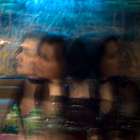Resilients Salon at "Burning Ice"
Posted June 18, 2012 by Maja KuzmanovićAs the closing session of the Burning Ice festival, FoAM organised a Resilients Salon on vegetal culture. We wanted to explore the complexity of relationships between culture and nature today, focusing on human-plant interactions. The core question of the evening was 'what possible futures can we envision emerging at the edges between culture, gardening and technology?' We invited four people working at these edges to warm up the conversations:
- Zack Denfeld and Catherine Kramer of the Center for Genomic Gastronomy, working on exploring and understanding genomes and biotechnology that make up our food systems
- Angelo Vermeulen who creates ecosystems as artworks and has recently begun researching the exciting field of astrobiology
- Tim Boykett from Time's Up, whose work ranges from physical storytelling, to augmented non-green gardening.
Zack and Cat talked about the lack of awareness of the 'Columbian exchange' – the historical moment when tomatoes, potatoes, chocolate and chillis flooded the world with new tastes that are now essential components of cuisines the world over.
Angelo talked about plants and heat in Biomodd, where he recycles energy from computers to heat up greenhouses for plants. He also discussed the Merapi Terraforming project, which uses rhizobia – a species of bacteria – to re-introduce nitrogen into a harsh environment in Indonesia that recently experienced a volcanic eruption.
Tim spoke about mushrooms and non-green gardening – ideal for people in urban and urban fringe areas with little or no access to sunlight for gardening. He also showed examples of recycling old clothing and shoes to grow mushrooms from, and talked about combining pre- and post-industrial techniques for gardening in places where there is no soil (such as the Time's Up harbour studio).
From there, the conversation spiraled in many interesting directions, and several potential seeds have been sewn for next year's festival:
- learning from the techniques of early agricultural societies (such as the Romans using manure to grow summer plants in the winter) and seeing how they can be combined with postindustrial crafts to encourage gardening in harsh urban deserts
- beware of the sudden surge in botanical art – is it a mere trend? similarly to the new media arts, we should not forget the history of eco-art, and people such as The Harrisons (http://theharrisonstudio.net/)
- astrobiology could be seen as XXX of sustainability (where molecules penetrate every body without discrimination), looking at closed-loop systems where every single molecule is shared and recycled between humans and other living and non-living systems
- leaving abandoned industrial sites to decay and be taken over by vegetation (Charlerois, Chernobyl…)
- turning pests into food, for example Ustilago maydis – corn smut fungus – that is seen as a blight, but is also edible
- should genetic engineering become an open source endeavour?
Of course, touching on genetic engineering opened up a whole can of worms of pros and cons, which ended in a vague conclusion that it is all a matter of values and a question of survival. We knew that this conversation could take days and years, so we moved on to another edge between culture, gardening and technology, namely seed-saving. Cat proposed that instead of military service, governments could propose that young men and women could fulfil their civic duty or their obligation to their communities by saving seeds or taking care of plants. Is the militarisation of gardening a possible future? Andrea Carafa noted from the audience that perhaps a student exchange might be a more feasible option, something like an Erasmus exchange for seed saving. We agreed that we'd also need to move from simply saving seeds to saving whole biotopes and ecosystems, as seeds cannot be stored forever, and they also adapt over time in nature.
Talking about seed-saving brought us to our favourite topic – food. Zack mentioned that in order to preserve biodiversity for the future, people should eat more varieties of food; for example carrots of various shapes and colours, or the hundreds of cultivars of aubergines in India, in danger of vanishing with the introduction of a single variety by Monsanto. To preserve biodiversity in the environment, we need more biodiversity in the kitchen! Diversity of ingredients, methods and ages – in Asian urban centres young generations rarely cook – an intergenerational exchange is urgently needed, before the elderly take their diverse skills and recipes to their graves: grandma's cooking as a political tactic!
The conversation ended with an interesting possible future: the tension between culture and nature is diminished by seeing them both as a part of a larger ecology, where culture is about adapting lifestyles to cuisines and inventing new rituals – and more importantly, new seasonal holidays – that would foster a renewed interest in preserving biodiversity – for the sake of eating it.
We finished the Salon by savouring a warm tomato soup, prepared while we were talking by Rasa Alksnyte and her team of improviser-chefs… In order to participate in the salon and get a chair to sit on, the audience members were asked to bring one tomato – whether grown, foraged or bought. From the diversity of tomatoes in a myriad of shapes, sizes and colours, the cooks whipped up a delicious soup that we ate eagerly, as the sun set and a bitter cold wind blew away our words and body heat.
Created: 15 Jul 2021 / Updated: 15 Jul 2021


